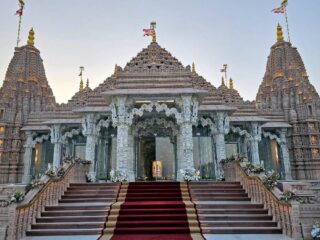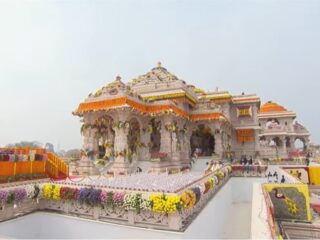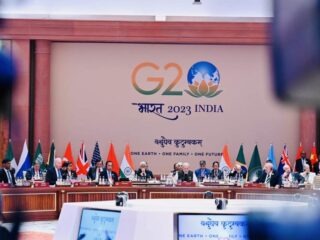By Irfan Engineer
(Secular Perspective May 1-15, 2013)
In the run up to the general elections, the campaign issues of the two major national parties are becoming clearer and sharper, as also acrimonious statements. The BJP’s campaign always has been – India is an ancient nation-civilization; that its vitality was lost due to invasions; that Congress is unable to restore the nation to its past glory as it emulates the west and continues with the institutional structures of British era; that the Congress cannot restore the “civilization consciousness” which makes India one country, one people and one nation, which is well defined by the sages and philosophers and which has its roots in Hindu world view (read upper caste); that the Congress appeases the minority for vote bank politics; that it is soft on Pakistan for the same reason; that Congress does not sabre rattle and bully its South Asian neighbors’ enough and plays ball with Pakistan; that large numbers of Bangladeshis are allowed to “infiltrate” into India from its eastern borders and even carryout terrorist acts; that Congress’ weakness has compromised the internal security; that Congress is unable to tackle separatism and terrorism, including Maoist terrorism, with firmness; and finally, the Congress will be unable to pull out the country from the slow economic growth, and therefore poverty, inflation, etc. In its manifesto for the 2009 Lok Sabha elections, the BJP states “What was required after independence was to reorient India’s polity to bring it in consonance with the seekings and sensibilities of the Indian people” (read upper caste Hindus). “Failure to do so has resulted in a fractured society, vast economic disparities, terrorism and communal conflict, insecurity, moral, psychological and spiritual degradation, and a state apparatus unable to handle any of these problems.” Corruption will be an additional issue exploited by the BJP in the general elections.
Though the diagnosis of BJP seems to identify Congress as centre of all ills facing the nation, Congress is blamed only for limited purpose of election, for being vehicle for the ills that afflict the nation. For the BJP, Congress is not the cause of the ills that afflict Hindu Rashtra– the ideological goal of the BJP. Hindu Rashtra has three declared enemies – Muslims, Christians, Communists and the western notion of citizenship and human rights, particularly, the notion of equality. Citizenship, human rights and equality are against the “Hindu” civilizational consciousness as defined by the sages. Congress is responsible for carrying along with it the Muslims, Christians and liberals. Congress is targeted for the purpose of elections.
Hindu Rashtra, Integral Humanism and Hindu Civilizational Consciousness
The Hindu civilizational consciousness is that of caste based hierarchy, which considers the dalits as untouchables less than even animals, as animals can be touched and some are even worshiped. Similarly, “Hindu” civilizational consciousness of ancient sages deprived women of their rights and human dignity and treated them to be chattels to be owned by their father in the first instance and after marriage by their husbands. Congress is the tool for the Muslims and Christians to claim citizenship rights. “From time to time, Congressmen have declared welfare state, socialism, liberalism etc. as their aims” laments Deendayal Upadhyay, former President of Bharatiya Jan Sangh – the earlier version of BJP – in one of his lectures.
BJP subscribes to Hindu Rashtra and Deendayal Upadhyay’s thesis of Integral Humanism. Integral Humanism terms the “social contract theory” as fundamentally incorrect. The theory views the norms and laws of collective society as implied agreement between the individuals. “It is true that the society is composed of a number of individuals”, writes Upadhyay, “yet it is not made by people, nor does it come into being by mere coming together of a number of individuals. In our view society is self-born.” Integral Humanism compares society to the Virat-purusha: “In our concept of four castes, they are thought of as analogous to the different limbs of Virat-purusha. It was suggested that from the head of the Virat-Purusha Bhrahmins were created, Kshatriyas from hands, Vaishyas from his abdomen and Shudras from legs. If we analyze this concept we are faced with the question whether there can arise any conflict among the head, arms, stomach and legs of the same Virat Purusha. If conflict is fundamental, the body cannot be maintained. There cannot be any conflict in the different parts of the same body. On the contrary “one man” prevails. These limbs are not only complementary to one another, but even further, there is individual unity. There is a complete identity of interest, identity of belonging. The origin of the caste system was on the above basis.” What appears to Deendayal Upadhyay as self-born society (and therefore natural) is a harmonious caste-based hierarchy with birth-based division of occupations – some enjoying the privileges while others confined to performing hard labour, producing goods and services, discharging duties imposed on them and performing menial work, including scavenging. This apportioning of privileges and duties among different section of society is based on coercion and force and is not self-born or natural. The use of force and coercion reflects even in the Epics of Ramayana and Mahabharata which Upadhyay fails to take note of before declaring it to be self-born – cutting off the thumb of Eklavya; killing of Shambhuk for reciting Vedas, Sita’s trial by fire, punishment prescribed if non-Brahmins recite or hear Vedas or resist performance of their duties, etc. But the purpose behind decrying liberty and dignity of individuals and the “social contract theory”, is to approve absolute subjugation of individuals to the “self-born” society in which all the sections of the society – viz. castes – live harmoniously without producing any conflict or without challenging the natural and “self-born”, but oppressive collective. Everybody needs to accept order, howsoever hierarchical and howsoever oppressive only for the sake of harmony because individuals have no agency and are not worthy – they are only supposed to be subservient for the sake of society and in fact, exist only for the sake of the “nation”.
The State, in integral humanism, is subservient to the nation, brought into existence to protect the nation, i.e. produce and maintain conditions in which the ideals of the nation can be translated into reality. Integral humanism terms the ideals of the nation as “Chiti”, which is analogous to the soul of an individual. According to Upadhyay, the laws that help manifest and maintain Chiti of a Nation are termed Dharma of that nation and it is this “Dharma” that is supreme. Anyone who abandons Dharma betrays the nation. The Chiti, or Hindu civilizational consciousness or Dharma that has survived over centuries – in spite of foreign aggression – is caste hierarchies and caste structured society. It is through khap panchayats that the Dharma or chiti or civilizational consciousness of the nation has survived over centuries and therefore it is eternal. BJP’s integral humanism propounds, that it is not the majority of people who decide what is good for them it is Dharma that decides what is good for people and therefore not democracy, not “Jana Rajya” but Dharma Rajya that is desired and the State has to sub-serve the nation by upholding Dharma (caste based) Rajya. So fundamental is the caste system to the BJP’s doctrine of Integral Humanism and the “civilizational consciousness” that neither the nation-state nor the majority of people can be trusted with it, indeed not the democratic state with liberalism or socialism or individual dignity or human rights. The “chiti” vests in a small coterie that will need the help of a militarized and authoritarian state to enforce it and all that the majority of the people need to do is to submit to this coterie else suffer oppressive and violent consequences. This is why Muslims, Christians and Communism are perceived as enemies of Hindu Rashtra. Their religious consciousness would not accept the “Dharma” that integral humanism propounds, as the concept of equality is at the core of their religious consciousness, even though not a social reality.
The Congress Party:
The Congress party perseveres to build the charisma of Rahul Gandhi, carefully and selectively fielding him for public events. Rahul Gandhi himself pretends to be a reluctant candidate who is more interested in bringing about change with the help of team Congress as against, ‘a man charging on a horse solving nation’s problems’. The Congress party is using or rather misusing the slogan of secularism to isolate the BJP from at least some of the NDA allies and scare away potential allies. The slogan of secularism is also handy to mobilize the minorities to electoral booths. To the industrialist, the Congress is promising reforms, albeit at a slow pace. To the marginalized sections like the adivasis and the dalits, whose votes it endeavours to mobilize, a few sops and poorly funded schemes that are even more poorly implemented to benefit the targeted group. Rahul Gandhi used the metaphor of beehive. The metaphor is apt as ordinary Indians work hard to help the country reach high growth rates only so that the honey of their labour and the natural resources of the country is slurped and polished off by the crony capitalist class. The Congress is more of a status-quoist party ushering pro-capital economic reforms in calibrated measures facilitating more and more influx and more or less free movement of foreign capital in order to maximize returns.
We should not mistake the contest between the BJP led NDA and Congress led UPA as that between two equally bad or corrupt political alliances or those having more or less same economic programmes. The contest between UPA and NDA is not between a corrupt and an honest party, nor between a minority appeaser and pseudo secular vs. truly secular party nor between development with human face and development on horseback – it is between two world views – hierarchically structured social system of Dharma enforced by totalitarian state or liberal values of liberty, equality and fraternity, for human dignity of all! Survival of democracy is at stake.
There are three issues that are creating conducive environment for the totalitarian forces to take over – 1) the economy of the country has slowed down due to its excessive dependence on exports after liberalization and on account of the economic crisis in Europe and US; 2) the media has been focusing almost exclusively on the issues of corruption since about last two years, if not more creating an impression of chaos and non-functional democracy and 3) perceived existence of an external enemy due to constant belligerence and sabre rattling on the borders with Pakistan is stoking feelings of worst form of jingoism among the urban middle-class which has benefitted from globalization. The opposition is trying its best to obstruct the functioning of Parliament on one pretext or the other to escalate the chaos and demonstrate impotency of democracy and democratic institutions. This situation is leading the common man, particularly the urban middle-class, to feel helpless and demand a strong authoritarian state. The communal forces have an authoritarian ideology just for the situation where people lose faith in democracy! The situation needs only one more factor for imposing a totalitarian regime on the basis of “Dharma” a theocratic state – a mass leader with charismatic qualities. That mass leader is being built up by the media, PR agencies, and the capitalist class in the form of Narendra Modi.
It is up to the electorate to make their choice




